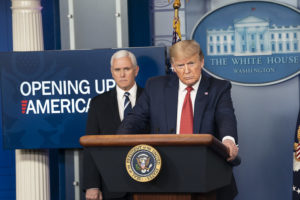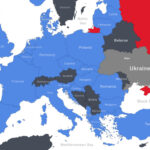
President Donald J. Trump, joined by Vice President Mike Pence and members of the White House COVID-19 Coronavirus task force, delivers remarks and answers questions from members of the press during a coronavirus update briefing Thursday, April 16, 2020, in the James S. Brady White House Press Briefing Room. (Official White House Photo by Joyce N. Boghosian)
Many have likened our world’s once-in-a-lifetime pandemic to WWII.
Robert O’Brien, a White House security advisor, outlines the measures President Trump initiated to fight coronavirus.
#1: Trump Assembles a Team
On 29 January Mr. Trump established the White House Coronavirus Task Force. Now under Vice President Mike Pence’s leadership, the taskforce has consolidated the government’s public-health expertise and responded in real time to the virus’s spread.
On 2 March Deborah Birx was detailed from the State Department to serve as the coronavirus response coordinator. Dr. Birx joined Anthony Fauci, director of the National Institute of Allergy and Infectious Diseases, and Robert Redfield, director of the Centers for Disease Control and Prevention.
#2 Trump Orders Travel Restrictions
On 31 January Mr. Trump ordered travel restrictions barring foreign nationals who had recently been in China from entering the U.S., quarantines for Americans who had visited China’s Hubei province, and a strong advisory against Americans traveling to China. These moves, unpopular at the time, allowed preparation for the large-scale arrival of the virus on U.S. shores.
#3 Trump Suspends Travel to U.S. for Foreign Nationals
On 11 March Mr. Trump suspended travel to the U.S. for foreign nationals who had recently been in 26 European nations, despite considerable pressure to exempt allies. The president extended these restrictions on 14 March to travel from the U.K. and Ireland, two of America’s closest partners. Again, this, given our countries’ unique and longstanding ties, was a difficult and controversial call.
#4 Trump Issues “15 Days to Slow the Spread” Initiative
On 16 March, as the virus began to stretch the public-health resources of major American cities such as Seattle and New York, Mr. Trump issued the “15 Days to Slow the Spread” initiative, which included strict social-distancing guidelines and recommendations for those with the highest risk of severe illness. Mr. Trump understood the economic consequences but acted to protect American lives.
After concluding that the damage to the economy would be even greater if the virus were permitted to spread unabated, the president extended these guidelines through 30 April. Thanks to the president’s early initiative, the U.S. economy will soon be in a position to reopen carefully on a rolling basis.
#5. Trump Announces Availability of Remdesivir
For many weeks the president pushed for the innovative use of therapies to fight the virus. On 18 March Mr. Trump announced the availability of Remdesivir for patients in emergency situations and in a national clinical trial. While not yet proved to work, the antiviral drug has shown promise in academic research and in treating a small number of Covid-19 patients. The Food and Drug Administration is looking at other experimental coronavirus treatments to provide more tools to physicians on the front lines.
#6. Trump Announces Guidelines for Cloth Masks
On 3 April Mr. Trump announced that the CDC would issue guidelines recommending that Americans use cloth masks to help stop the spread of the virus and pave the way to get back to work. While some health-care experts had dismissed the idea, the president saw new research on the benefits of masks and successful examples in South Korea, Hong Kong and Taiwan, and quickly communicated this information.
#7 Trump Breaks Through Bureaucratic Red Tape
The president initiated a public-private partnership, Project Airbridge, to fly in essential personal protective equipment from around the globe. Working with governors, mayors, manufacturers and hospitals, the Trump administration has used every tool available, including the Defense Production Act, to break through bureaucratic red tape and ensure that critical supplies are prioritized and delivered to where they are needed most.
If you’re willing to fight for Main Street America, click here to sign up for the Richardcyoung.com free weekly email.





